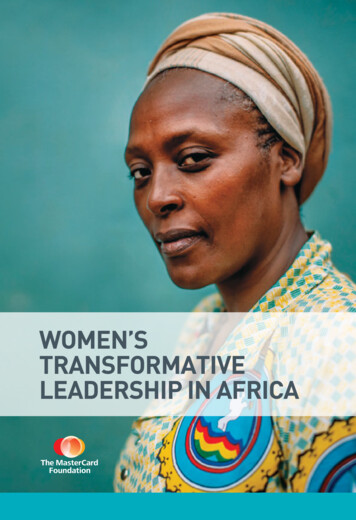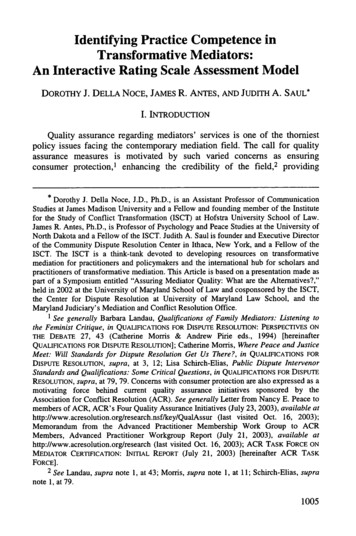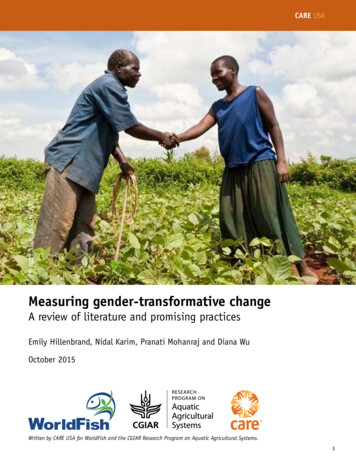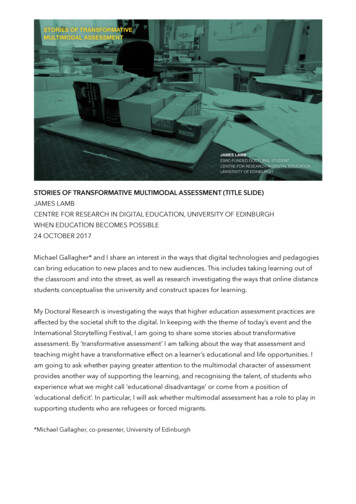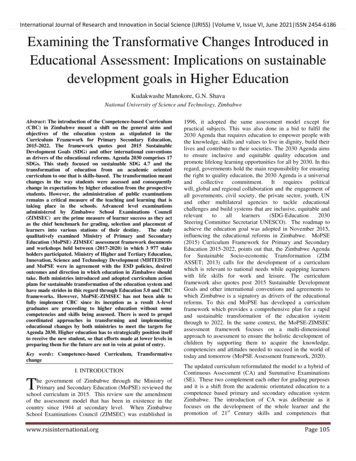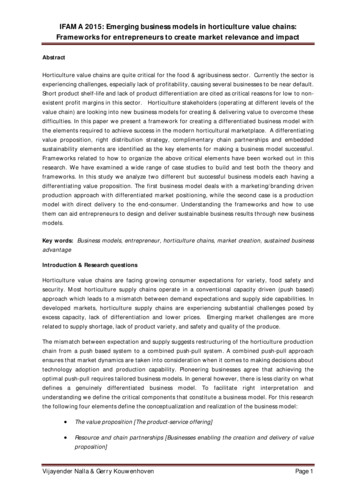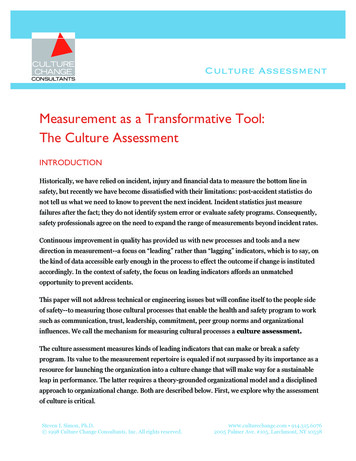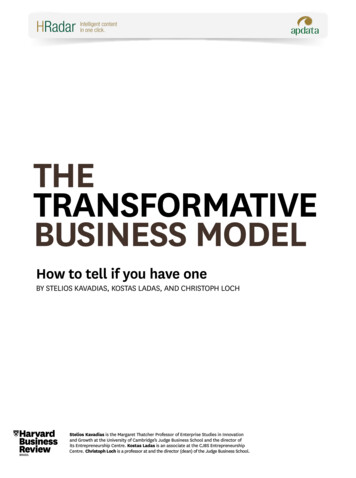
Transcription
HRadarIntelligent contentin one click.TheTransformaTiveBusiness modelhow to tell if you have oneby StelioS KavadiaS, KoStaS ladaS, and ChriStoph loChStelios Kavadias is the Margaret Thatcher Professor of Enterprise Studies in Innovationand Growth at the University of Cambridge’s Judge Business School and the director ofits Entrepreneurship Centre. Kostas Ladas is an associate at the CJBS EntrepreneurshipCentre. Christoph Loch is a professor at and the director (dean) of the Judge Business School.
HRadarIntelligent contentin one click.THe TranSforMaTive BuSineSS ModeLWe usually associate anindustry’s transformationwith the adoption of a newtechnology. But althoughnew technologies areoften major factors, theyhave never transformedan industry on their own.What does achieve sucha transformation is abusiness model that canlink a new technology toan emerging market need.MP3 technology is a classic case in point. EarlyMP3 devices represented an order-of-magnitudeincrease in capacity over magnetic tapes and CDs:Users could carry thousands of songs on a smalldevice. But MP3 players revolutionized the audiodevices market only after Apple coupled the iPodwith iTunes in a new business model, swiftly moving music-recording sales from the physical to thevirtual world.What, exactly, enables a business model to deliver on a technology’s potential? To answer thatquestion, we embarked on an in-depth analysisof 40 companies that had launched new businessmodels in a variety of industries. Some succeededin radically altering their industries; others lookedpromising but ultimately did not succeed. In thisarticle we present the key takeaways from our research and suggest how they can help innovatorstransform industries.2 Harvard Business Review october 2016How Business Models WorkDefinitions of “business model” vary, but mostpeople would agree that it describes how a company creates and captures value. The features of themodel define the customer value proposition andthe pricing mechanism, indicate how the companywill organize itself and whom it will partner with toproduce value, and specify how it will structure itssupply chain. Basically, a business model is a systemwhose various features interact, often in complexways, to determine the company’s success.In any given industry, a dominant business modeltends to emerge over time. In the absence of marketdistortions, the model will reflect the most efficientway to allocate and organize resources. Most attempts to introduce a new model fail—but occasionally one succeeds in overturning the dominantmodel, usually by leveraging a new technology. Ifnew entrants use the model to displace incumbents,
HRadarIntelligent contentin one click.idea in BriefThe quesTionNo new technology can transform anindustry unless a business model can linkit to an emerging market need. How canyou tell whether a model will succeed indoing that?The researchThe authors undertook an in-depthanalysis of 40 companies that launchednew business models in a variety ofindustries. Some had transformed theirindustries; others looked promising butultimately didn’t succeed.or if competitors adopt it, then the industry hasbeen transformed.Consider Airbnb, which upended the hotel industry. Founded in 2008, the company has experiencedphenomenal growth: It now has more rooms than either InterContinental Hotels or Hilton Worldwide. Asof this writing, Airbnb represents 19.5% of the hotelroom supply in New York and operates in 192 countries, in which it accounts for 5.4% of room supply(up from 3.6% in 2015).The founders of Airbnb realized that platformtechnology made it feasible to craft an entirely newbusiness model that would challenge the traditionaleconomics of the hotel business. Unlike conventional hotel chains, Airbnb does not own or manageproperty—it allows users to rent any livable space(from a sofa to a mansion) through an online platform that matches individuals looking for accommodations with home owners willing to share a room ora house. Airbnb manages the platform and takes apercentage of the rent.Because its income does not depend on owning or managing physical assets, Airbnb needs nolarge investments to scale up and thus can chargelower prices (usually 30% lower than hotels charge).Moreover, since the home owners are responsiblefor managing and maintaining the property and anyservices they may offer, Airbnb’s risks (not to mention operational costs) are much lower than thoseof traditional hotels. On the customer side, Airbnb’smodel redefines the value proposition by offering amore personal service—and a cheaper one.Before platform technology existed, there was noreason to change the hotel business in any meaningful way. But after its introduction, the dominant business model became vulnerable to attack from anyonewho could leverage that technology to create a morecompelling value proposition for customers. The newThe findingsTransformative business models tend toinclude three or more of these features:(1) personalization, (2) a closed-loopprocess, (3) asset sharing, (4) usage-basedpricing, (5) a collaborative ecosystem, and(6) an agile and adaptive organization.business model serves as the interface between whattechnology enables and what the marketplace wants.Let’s look now at what features make a businessmodel transformative.The Six Keys to SuccessWe selected the 40 new business models we analyzed on the basis of how many mentions they received in the high-quality, high-circulation businesspress. All of them seemed to have the potential totransform their industries, but only a subset had succeeded in doing so. We looked for recurring featuresin the models and found six. No company displayedall of them, but as we shall see, a higher numberof these features usually correlated with a higherchance of success at transformation.1 a more personalized product or service.Many new models offer products or services thatare better tailored than the dominant modelsto customers’ individual and immediate needs.Companies often leverage technology to achievethis at competitive prices.2 a closed-loop process.Many models replace a linear consumption process (in which products are made, used, and thendisposed of) with a closed loop, in which usedproducts are recycled. This shift reduces overallresource costs.3 asset sharing.Some innovations succeed because they enable the sharing of costly assets—Airbnb allowshome owners to share them with travelers, andUber shares assets with car owners. Sometimesassets may be shared across a supply chain. Thesharing typically happens by means of two-sidedonline marketplaces that unlock value for bothsides: I get money from renting my spare room,and you get a cheaper and perhaps nicer placeoctober 2016 Harvard Business Review 3
HRadarIntelligent contentin one click.THe TranSforMaTive BuSineSS ModeLLinking Technology and the MarketThe six features that characterize successful innovation all link a recognized technology trend and a recognizedmarket need. Trends were identified by an analysis of regularly published industry reports from think tanksand consulting companies such as the McKinsey Global Institute, PwC, and the Economist Intelligence Unit.TeCH TrendSKeyS To innovaTion SuCCeSSMarKeT needSsensing, interfacing, andmaterial technologiespersonalizaTionincrease in demand forproducts and servicesclosed loopoptimization technologies(ai, big data, robotics)more diversity of consumerpreferencesasseT sharingplatforms for connectingdevicesusage-Basedpricingmobility and cloudtechnologiesrise of input costs (resources,labor, transportation)collaBoraTiveecosysTemdecentralized small-scalemanufacturing (3-d printing)agiliTyto stay. Sharing also reduces entry barriers tomany industries, because an entrant need notown the assets in question; it can merely act asan intermediary.4 usage-based pricing.Some models charge customers when they usethe product or service, rather than requiringthem to buy something outright. The customersbenefit because they incur costs only as offeringsgenerate value; the company benefits becausethe number of customers is likely to grow.5 a more collaborative ecosystem.Some innovations are successful because anew technology improves collaboration withsupply chain partners and helps allocate businessrisks more appropriately, making cost reductionspossible.6 an agile and adaptive organization.Innovators sometimes use technology to moveaway from traditional hierarchical models ofdecision making in order to make decisions thatbetter reflect market needs and allow real-timeadaptation to changes in those needs. The resultis often greater value for the customer at less costto the company.Each feature on this list is tied to long-term trendsin both technology and demand. (See the exhibit“Linking Technology and the Market.”) On the tech4 Harvard Business Review october 2016greater regulatory pressureside, one trend is the development of sensors thatallow cheaper and broader data capture. Anotheris that big data, artificial intelligence, and machinelearning are enabling companies to turn enormousamounts of unstructured data into rules and decisions. A third is that connected devices (the internetof things) and cloud technology are permitting decentralized and widespread data manipulation andanalysis. And a fourth is that developments in manufacturing (think nanotechnology and 3-D printing)are creating more possibilities for distributed andsmall-scale production.On the market side, although the steady progressof developing countries has led to a stable increasein demand worldwide, it is complicated by a greaterdiversity in customer preferences (both across andwithin countries). Higher factor prices (despite thecommodity price reductions of 2015) and heightenedregulation (notably on environmental effects andbusiness conduct) further increase the challengesfor companies looking to gain market share.All six features represent potential solutions forlinking market demand and technological capability. For example, greater personalization in thevalue proposition responds to the fragmentationof consumer preferences and the resultant demandfor more-diverse offerings. That personalizationhas been made possible by sensors that collect data
HRadarIntelligent contentin one click.from connected devices via the cloud; the data isanalyzed by big data solutions and turned into services—such as recommendations and alerts—thatare different for each user.from innovation to TransformationIn theory, the more of the six features a new businessmodel has, the greater its potential to transform agiven industry should be. We tested that hypothesisby analyzing how many features each of the 40 newmodels displayed and comparing the results with itsactual performance.We gave each model one point for each featureon which it outperformed the incumbent businessmodel. We then assessed its transformative successaccording to the degree to which the model had attracted market share (displacing incumbents) andthe extent to which other companies had copied it.Our results strongly suggest (that’s the best one canget from statistical analyses) that business modelswith transformative potential tend to have threeor more of the six features. (See the exhibit “HowMany Boxes Should a Model Tick?”)The taxi service company Uber ticks no fewerthan five boxes. Its business model is built on assetsharing—the drivers use their own cars. Uber has developed a collaborative ecosystem in which the driverassumes the risk of winning rides, while the platformhelps minimize that risk through the application ofbig data. The platform also creates agility throughan internal decision-making system that respondsto market changes in real time. This lets Uber applyusage-based pricing and direct drivers to locationswhere the probability of finding a fare is high.Finally, Uber uses a scheme whereby customersrate drivers. Via the big data platform, a would-becustomer can see on his or her mobile device theclosest drivers and their ratings. The rating systempushes drivers to offer clean cars and quality service,and it also provides at least a bit of personalization.Allowing the customer to decide between the closest car and the one (maybe a bit farther out) with thehighest rating may not sound like much, but it is stillfar ahead of traditional taxi services.The implication of our finding is straightforward:If you are thinking about changing your businessmodel or entering an industry with a new model,you can rate yourself on how well your model performs on the six features. If you don’t beat the competition on any of them, your chances of success arelow. But if your model significantly outdoes the current model on three or more features, you are wellpositioned to succeed.To rate yourself on a feature, you must first definewhat it actually means in your industry. For example,in financial services personalization may mean tailored loan terms (including interest rates, monthlypayments, and loan duration), whereas in retail itmay mean customized T-shirt designs or one-offdresses. In education it may mean that the supportprovided to students changes according to their individual strengths and weaknesses, and in health careit may mean data-enabled, targeted medicine. Onlywhen performance is expressed in such industryspecific ways can a company develop metrics toevaluate and compare its model on the key featuresand begin to think about how to differentiate itselfby using new technologies.Uber can claimfive of the sixkey features ofa potentiallytransformativebusiness model.Healx: a Case StudyInformed by our business model framework, weadvised (and Cambridge Judge Business School’sbusiness accelerator supported) the tech ventureHealx, which focuses on the treatment of patientswith rare diseases in the emerging field of personalized medicine. A big challenge for pharmaceutical companies in this domain is that rare-diseasemarkets are very small, so companies usually haveto charge astronomical prices. (One drug, Soliris,used in the treatment of paroxysmal nocturnalhemoglobinuria, costs about 500,000 per patientyear.) Some potential treatments are, however,being used for more-common diseases withlarge patient markets. They could be repurposedto suit the needs of rare-disease sufferers, butoctober 2016 Harvard Business Review 5
HRadarIntelligent contentin one click.THe TranSforMaTive BuSineSS ModeLAGIlITySCOREXX41AIRBNBREAl ESTATEX2AlIBABARETAIlXXX3AMAzONRETAIlXXX4APPEAR HEREREAl ESTATE RENTAlS5APPlE UCATIONX11ETSyRETAIlX12GOOGlE AdWORdSAdvERTISINGX13HANdyHOME REAl ESTATEX17lEGO fACTORyTOySX18lENdING ClUBBANKING19lIvEOPSCAll CENTERS20lyfTTAXI OPERATIONXX21M-PESABANKINGX22MEdICASTHEAlTH CAREX23NATURACOSMETICS24NIKE IdfOOTWEAR25PHIlIPS PAy PER lUXlIGHTINGX26RICOH PAy PER PAGEElECTRONICS27ROllS-ROyCE AlESfORCE.COMSOfTWAREX30SHyPTRANSPORT & lOGISTICSX31TASKRABBITHOME SERvICES32TENCENT QQSOfTWAREX33UBERTAXI OPERATIONX34UdACITyEdUCATIONX35WASHIOdRy ClEANINGX36WAyfAIRHOME PORTATIONXX40zOPABANKINGXXthey typically work only for people with specificgenetic profiles.Enter Healx, with a platform that leverages6 Harvard Business Review october TRyASSET SHARINGBUSINESSClOSEd lOOPOur research suggests that to transform an industry, a businessmodel must display at least three of the six key features. Here’show the 40 new models we examined stacked up.PERSONAlIzATIONHow Many Boxes Should a Model XXXXX3XX52X3XX3X2X3XX4XX4XXXXbig data technology and analytics across multipledatabases owned by various organizations withinglobal life sciences and health care to efficiently
HRadarIntelligent contentin one click.match treatments to rare-disease patients. Its initial business model hit three of our six key features.First, Healx’s value proposition was about assetsharing (for example, making available clinicaltrial databases that record the effectiveness of mostdrugs across therapeutic areas and diseases, including rare ones). Second, the business promised morepersonalization by revealing drugs with high potential for treating the rare diseases covered. Finally,Healx’s model would, in theory, create a collaborative ecosystem by bringing together big pharma(which has the treatment and trial data) and healthcare providers (which have data about effectivenessand incompatibility reactions and also personalgenome descriptions).How did we measure performance along thosefeatures? To assess personalization, we comparedthe amount of drug data currently provided tosufferers of rare diseases with the amount thatHealx could provide, which initially covered 1,000of the 7,000 rare diseases that have formal advocacy groups worldwide. These groups representsome 350 million people, 95% of whom currentlyget no even reasonably relevant drug recommendations. We measured asset sharing by lookingat the proportion of known data on rare-diseaserelevant drugs that Healx could access—about20% in its start-up phase. Finally, we assessed itscollaborative ecosystem by looking at how many ofthe main data-holding institutions participated—about a quarter.At first Healx struggled to get pharma companiesto join the platform; they were concerned that theirtreatment data would leak to competitors. But theHealx team spotted an opportunity to give companies an incentive. In 2014 the United Kingdom’sNational Health Service introduced a new rule forpharmaceutical companies: If an expensive treatment doesn’t work for a patient, the company responsible can be forced to reimburse NHS providers for its cost. The reimbursement amounts weredisease-specific and counted in the thousands ofBritish pounds.Treatment failure is often caused by specificities in individual genomes, and Healx’s managersrealized that their technology could help companiespredict such failures with high accuracy, potentiallysaving millions of pounds a year.More recently, Healx has developed a machine-learning algorithm that can use a patient’sbiological information not only to match drugsto disease symptoms but also to predict exactlywhich drug will achieve what level of effectivenessfor that particular patient. The latest version of itsbusiness model brings personalization to the maximum possible level and adds agility, because thetreating clinician—armed with the biological dataand the algorithm—can make better treatment decisions directly with the patient and doesn’t have torely on fixed rules of thumb about which of the fewavailable off-label drugs to use. In this way, Healx isable to support decentralized, real-time, accuratedecision making.The latest versionof Healx’s businessmodel bringspersonalizationto the maximumpossible level.This version of the Healx model has even moretransformation potential—it exhibits four of thesix features; it has already generated revenue fromcustomers; and in the long term it could empowerpatients by giving them much more information before they consult a medical practitioner. Although itis still too early to tell whether that potential will berealized, Healx is clearly a venture to watch. It hasearned a number of prizes (including the 2015 LifeScience Business of the Year and the 2016 GraduateBusiness of the Year in the Cambridge cluster) andsizable investments from several global funds.you CannoT guarantee the success of an innovation(unless you choose a market niche so small as to beinsignificant). But you can load the dice by ensuring that your business model links market needswith emerging technologies. The more such linksyou can make, the more likely you are to transformyour industry.HBr reprint R1610Hoctober 2016 Harvard Business Review 7
may mean customized T-shirt designs or one-off dresses. In education it may mean that the support provided to students changes according to their indi-vidual strengths and weaknesses, and in health care it may mean data-enabled, targeted medicine. Only when performance is expressed in such industry- specif
